Pervasive Listwaenitization: The Role of Subducted Sediments within Mantle Wedge, W. Chalkidiki Ophiolites, N. Greece
Abstract
:1. Introduction
2. Geological Settings
3. Materials and Methods
4. Results
4.1. Field Geology and Petrography
4.2. Mineral Chemistry
4.3. Geochemistry
5. Discussion
5.1. Peridotite Pervasive Listawaenitization into ‘Quartzite’ and Late-Stage Clay Mineral Genesis—Geochemical Changes
5.2. Thermodynamic Modeling of Proto-Listwaenite and Silica-Rich Listwaenite
5.3. Geotectonic Implications and the Role of Subducted Sediments within the Mantle Wedge in Inducing Metasomatism
6. Conclusions
Supplementary Materials
Author Contributions
Funding
Data Availability Statement
Acknowledgments
Conflicts of Interest
References
- Tsikouras, B.; Karipi, S.; Grammatikopoulos, T.A.; Hatzipanagiotou, K. Listwaenite evolution in the ophiolite mélange of Iti Mountain (continental Central Greece). Eur. J. Mineral. 2006, 18, 243–255. [Google Scholar] [CrossRef]
- Arai, S.; Okamura, H.; Kadoshima, K.; Tanaka, C.; Suzuki, K.; Ishimaru, S. Chemical characteristics of chromian spinel in plutonic rocks: Implications for deep magma processes and discrimination of tectonic setting. Isl. Arc. 2011, 20, 125–137. [Google Scholar] [CrossRef] [Green Version]
- Austrheim, H.; Corfu, F.; Renggli, C.J. From peridotite to fuchsite bearing quartzite via carbonation and weathering: With implications for the Pb budget of continental crust. Contrib. Miner. Petrol. 2021, 176, 94. [Google Scholar] [CrossRef]
- Boskabadi, A.; Pitcairn, I.K.; Leybourne, M.I.; Teagle, D.A.H.; Cooper, M.J.; Hadizadeh, H.; Nasiri Bezenjani, R.; Monazzami Bagherzadeh, R. Carbonation of ophiolitic ultramafic rocks: Listvenite formation in the Late Cretaceous ophiolites of eastern Iran. Lithos 2020, 352–353, 105307. [Google Scholar] [CrossRef]
- Menzel, M.D.; Urai, J.L.; de Obeso, J.C.; Kotowski, A.; Manning, C.E.; Kelemen, P.B.; Kettermann, M.; Jesus, A.P.; Harigane, Y. Brittle Deformation of Carbonated Peridotite—Insights From Listvenites of the Samail Ophiolite (Oman Drilling Project Hole BT1B). J. Geophys. Res. Solid Earth 2020, 125, e2020JB020199. [Google Scholar] [CrossRef]
- Mattern, F.; Scharf, A. Postobductional extension along and within the Frontal Range of the Eastern Oman Mountains. J. Asian Earth Sci. 2018, 154, 369–385. [Google Scholar] [CrossRef]
- Moctar, D.O.; Moukadiri, A.; Boushaba, A.; Lemine, S.O.M.; Dubois, M. Petrographical and Geochemical Characteristics of the Mauritanides Belts’ Birbirites. In Conference of the Arabian Journal of Geosciences; Springer: Berlin/Heidelberg, Germany, 2019; pp. 55–57. [Google Scholar]
- Menzel, M.D.; Garrido, C.J.; López Sánchez-Vizcaíno, V.; Marchesi, C.; Hidas, K.; Escayola, M.P.; Delgado Huertas, A. Carbonation of mantle peridotite by CO2-rich fluids: The formation of listvenites in the Advocate ophiolite complex (Newfoundland, Canada). Lithos 2018, 323, 238–261. [Google Scholar] [CrossRef]
- Peuble, S.; Andreani, M.; Gouze, P.; Pollet-Villard, M.; Reynard, B.; Van de Moortele, B. Multi-scale characterization of the incipient carbonation of peridotite. Chem. Geol. 2018, 476, 150–160. [Google Scholar] [CrossRef]
- Boskabadi, A.; Pitcairn, I.K.; Broman, C.; Boyce, A.; Teagle, D.A.H.; Cooper, M.J.; Azer, M.K.; Stern, R.J.; Mohamed, F.H.; Majka, J. Carbonate alteration of ophiolitic rocks in the Arabian–Nubian Shield of Egypt: Sources and compositions of the carbonating fluid and implications for the formation of Au deposits. Int. Geol. Rev. 2017, 59, 391–419. [Google Scholar] [CrossRef]
- Abu-Jaber, N.S.; Kimberley, M.M. Origin of ultramafic-hosted vein magnesite deposits. Ore Geol. Rev. 1992, 7, 155–191. [Google Scholar] [CrossRef]
- Kelemen, P.B.; Matter, J.; Streit, E.E.; Rudge, J.F.; Curry, W.B.; Blusztajn, J. Rates and mechanisms of mineral carbonation in peridotite: Natural processes and recipes for enhanced, in situ CO2 capture and storage. Annu. Rev. Earth Planet. Sci. 2011, 39, 545–576. [Google Scholar] [CrossRef]
- Pohl, W. Genesis of magnesite deposits–models and trends. Geol. Rundsch. 1990, 79, 291–299. [Google Scholar] [CrossRef]
- Gartzos, E. Comparative stable isotopes study of the magnesite deposits of greece. Bull. Geol. Soc. Greece 2004, 36, 196. [Google Scholar] [CrossRef]
- Emam, A.; Zoheir, B. Au and Cr mobilization through metasomatism: Microchemical evidence from ore-bearing listvenite, South Eastern Desert of Egypt. J. Geochem. Explor. 2013, 125, 34–45. [Google Scholar] [CrossRef]
- Tzamos, E.; Bussolesi, M.; Grieco, G.; Marescotti, P.; Crispini, L.; Kasinos, A.; Storni, N.; Simeonidis, K.; Zouboulis, A. Mineralogy and geochemistry of ultramafic rocks from rachoni magnesite mine, Gerakini (Chalkidiki, Northern Greece). Minerals 2020, 10, 934. [Google Scholar] [CrossRef]
- Tarkian, M.; Naidenova, E.; Zhelyaskova-Panayotova, M. Platinum-group minerals in chromitites from the Eastern Rhodope ultramafic complex, Bulgaria. Miner. Petrol. 1991, 44, 73–87. [Google Scholar] [CrossRef]
- Koutsovitis, P. High-pressure subduction-related serpentinites and metarodingites from East Thessaly (Greece): Implications for their metamorphic, geochemical and geodynamic evolution in the Hellenic–Dinaric ophiolite context. Lithos 2017, 276, 122–145. [Google Scholar] [CrossRef]
- Deschamps, F.; Guillot, S.; Godard, M.; Andreani, M.; Hattori, K. Serpentinites act as sponges for fluid-mobile elements in abyssal and subduction zone environments. Terra Nov. 2011, 23, 171–178. [Google Scholar] [CrossRef]
- Ismail, S.A.; Koshnaw, R.I.; Barber, D.E.; Humadi, H.A.; Stockli, D.F. Generation and exhumation of granitoid intrusions in the Penjween ophiolite complex, NW Zagros of the Kurdistan region of Iraq: Implications for the geodynamic evolution of the Arabian-Eurasian collision zone. Lithos 2020, 376, 105714. [Google Scholar] [CrossRef]
- Al Humadi, H.; Väisänen, M.; Ismail, S.A.; Lehtonen, M.; Johanson, B. Subducted basalts and sediments as sources for felsic dykes in the mawat ophiolite, NE Iraq. Ofioliti 2021, 46, 27–41. [Google Scholar] [CrossRef]
- Sideridis, A.; Zaccarini, F.; Koutsovitis, P.; Grammatikopoulos, T.; Tsikouras, B.; Garuti, G.; Hatzipanagiotou, K. Chromitites from the Vavdos ophiolite (Chalkidiki, Greece): Petrogenesis and geotectonic settings; constrains from spinel, olivine composition, PGE mineralogy and geochemistry. Ore Geol. Rev. 2021, 137, 104289. [Google Scholar] [CrossRef]
- Giamas, V.; Koutsovitis, P.; Sideridis, A.; Turberg, P.; Grammatikopoulos, T.A.; Petrounias, P.; Giannakopoulou, P.P.; Koukouzas, N.; Hatzipanagiotou, K. Effectiveness of X-ray micro-CT applications upon mafic and ultramafic ophiolitic rocks. Micron 2022, 158, 103292. [Google Scholar] [CrossRef] [PubMed]
- Kauffmann, G.; Kockel, F.; Mollat, H. Notes on the stratigraphic and paleogeographic position of the Svoula Formation in the innermost zone of the Hellenides (northern Greece). Bull. la Société Géologique Fr. 1976, S7-XVIII, 225–230. [Google Scholar] [CrossRef]
- Meinhold, G.; Kostopoulos, D.K. The Circum-Rhodope Belt, northern Greece: Age, provenance, and tectonic setting. Tectonophysics 2013, 595, 55–68. [Google Scholar] [CrossRef]
- Meinhold, G.; Kostopoulos, D.; Reischmann, T.; Frei, D.; BouDagher-Fadel, M.K. Geochemistry, provenance and stratigraphic age of metasedimentary rocks from the eastern Vardar suture zone, northern Greece. Palaeogeogr. Palaeoclimatol. Palaeoecol. 2009, 277, 199–225. [Google Scholar] [CrossRef]
- Sideridis, A.; Zaccarini, F.; Grammatikopoulos, T.; Tsitsanis, P.; Tsikouras, B.; Pushkarev, E.; Garuti, G.; Hatzipanagiotou, K. First occurrences of ni-phosphides in chromitites from the ophiolite complexes of alapaevsk, Russia and gerakini-ormylia, Greece. Ofioliti 2018, 43, 75–84. [Google Scholar] [CrossRef]
- Bonev, N.; Marchev, P.; Moritz, R.; Filipov, P. Timing of igneous accretion, composition, and temporal relation of the Kassandra–Sithonia rift-spreading center within the eastern Vardar suture zone, Northern Greece: Insights into Jurassic arc/back-arc systems evolution at the Eurasian plate margin. Int. J. Earth Sci. 2015, 104, 1837–1864. [Google Scholar] [CrossRef]
- Jochum, K.P.; Nohl, U.; Rothbarth, N.; Schwager, B.; Stoll, B.; Weis, U. Geostandards and Geoanalytical Research Bibliographic Review 2011. Geostand. Geoanalytical Res. 2012, 36, 415–419. [Google Scholar] [CrossRef]
- Dias, N.M.P.; Gonçalves, D.; Leite, W.C.; Brinatti, A.M.; Saab, S.C.; Pires, L.F. Morphological characterization of soil clay fraction in nanometric scale. Powder Technol. 2013, 241, 36–42. [Google Scholar] [CrossRef]
- Bosi, F.; Biagioni, C.; Pasero, M. Nomenclature and classification of the spinel supergroup. Eur. J. Miner. 2019, 31, 183–192. [Google Scholar] [CrossRef] [Green Version]
- Pagé, P.; Barnes, S.-J. Using trace elements in chromites to constrain the origin of podiform chromitites in the Thetford Mines Ophiolite, Québec, Canada. Econ. Geol. 2009, 104, 997–1018. [Google Scholar] [CrossRef]
- Leake, B.E.; Woolley, A.R.; Arps, C.E.S.; Birch, W.D.; Gilbert, M.C.; Grice, J.D.; Hawthorne, F.C.; Kato, A.; Kisch, H.J.; Krivovichev, V.G.; et al. Nomenclature of amphiboles: Report of the subcommittee on amphiboles of the international mineralogical association commission on new minerals and mineral names. Miner. Mag. 1997, 61, 295–321. [Google Scholar] [CrossRef]
- Hey, M.H. A new review of the chlorites. Minerl. Mag. J. Miner. Soc. 1954, 30, 277–292. [Google Scholar] [CrossRef]
- Kranidiotis, P.; MacLean, W.H. Systematics of chlorite alteration at the Phelps Dodge massive sulfide deposit, Matagami, Quebec. Econ. Geol. 1987, 82, 1898–1911. [Google Scholar] [CrossRef]
- Sun, S.-S.; McDonough, W.F. Chemical and Isotopic Systematics of Oceanic Basalts: Implications for Mantle Composition and Processes; Geological Society: London, UK, 1989; Volume 42, pp. 313–345. [Google Scholar]
- Plank, T. The Chemical Composition of Subducting Sediments; Elsevier: Amsterdam, The Netherlands, 2013; Volume 4, ISBN 9780080983004. [Google Scholar]
- Petrounias, P.; Giannakopoulou, P.P.; Rogkala, A.; Sideridis, A.; Koutsovitis, P.; Lampropoulou, P.; Koukouzas, N.; Pomonis, P.; Hatzipanagiotou, K. Influence of Petrogenesis on the Engineering Properties of Ultramafic Aggregates and on Their Suitability in Concrete. Appl. Sci. 2022, 12, 3990. [Google Scholar] [CrossRef]
- Naldrett, A.J.; Duke, J.M. Platinum metals in magmatic sulfide ores. Science 1980, 208, 1417–1424. [Google Scholar] [CrossRef]
- Qiu, T.; Zhu, Y. Chromian spinels in highly altered ultramafic rocks from the Sartohay ophiolitic mélange, Xinjiang, NW China. J. Asian Earth Sci. 2018, 159, 155–184. [Google Scholar] [CrossRef]
- Schwarzenbach, E.M.; Vogel, M.; Fruüh-Green, G.L.; Boschi, C. Serpentinization, Carbonation, and Metasomatism of Ultramafic Sequences in the Northern Apennine Ophiolite (NW Italy). J. Geophys. Res. Solid Earth 2021, 126, e2020JB020619. [Google Scholar] [CrossRef]
- Power, I.M.; Wilson, S.A.; Dipple, G.M. Serpentinite Carbonation for CO2 Sequestration. Elements 2013, 9, 115–121. [Google Scholar] [CrossRef]
- Frost, R.B.; Beard, J.S. On silica activity and serpentinization. J. Petrol. 2007, 48, 1351–1368. [Google Scholar] [CrossRef] [Green Version]
- Kimball, K.L. Effects of hydrothermal alteration on the compositions of chromian spinels. Contrib. Miner. Petrol. 1990, 105, 337–346. [Google Scholar] [CrossRef]
- Uysal, I.; Zaccarini, F.; Sadiklar, M.B.B.; Garuti, G. Occurrence of rare Ru-Fe-Os-Ir-oxide and associated Platinum-group minerals (PGM) in the chromitite of Mugla ophiolite, SW-Turkey. Neues Jahrb. Miner. (Abhandlungen) 2009, 185, 323–333. [Google Scholar] [CrossRef]
- Grieco, G.; Bussolesi, M.; Eslami, A.; Gentile, A.; Cavallo, A.; Lian, D.; Yang, J.; Ghaseminejad, F. Differential platinum group elements (PGE) re-mobilization at low fS2 in Abdasht and Soghan mafic-ultramafic complexes (Southern Iran). Lithos 2020, 366, 105523. [Google Scholar] [CrossRef] [Green Version]
- Farré-de-Pablo, J.; Proenza, J.A.; González-Jiménez, J.M.; Aiglsperger, T.; Torró, L.; Domènech, C.; Garcia-Casco, A. Low-temperature hydrothermal Pt mineralization in uvarovite-bearing ophiolitic chromitites from the Dominican Republic. Miner. Depos. 2021, 57, 955–976. [Google Scholar] [CrossRef]
- Daoudi, L. Palygorskite in the uppermost Cretaceous–Eocene rocks from Marrakech High Atlas, Morocco. J. Afr. Earth Sci. 2004, 39, 353–358. [Google Scholar] [CrossRef]
- Kadīr, S.; Erkoyun, H.; Eren, M.; Huggett, J.; Önalgil, N. Mineralogy, Geochemistry, and Genesis of Sepiolite and Palygorskite in Neogene Lacustrine Sediments Eskīşehīr Province, West Central Anatolia, Turkey. Clays Clay Miner. 2016, 64, 145–166. [Google Scholar] [CrossRef]
- Rasooli, N.; Farpoor, M.H.; Mahmoodabadi, M.; Esfandiarpour Boroujeni, I. Genesis and distribution of different mineral assemblages controlled by environmental factors in soils and evaporitic deposits of Lut Desert, central Iran. Environ. Earth Sci. 2021, 80, 779. [Google Scholar] [CrossRef]
- Inoue, A. Formation of Clay Minerals in Hydrothermal Environments. In Origin and Mineralogy of Clays; Springer: Berlin/Heidelberg, Germany, 1995; pp. 268–329. [Google Scholar]
- Bonatti, E.; Craig Simmons, E.; Breger, D.; Hamlyn, P.R.; Lawrence, J. Ultramafic rock/seawater interaction in the oceanic crust: Mg-silicate (sepiolite) deposit from the Indian Ocean floor. Earth Planet. Sci. Lett. 1983, 62, 229–238. [Google Scholar] [CrossRef]
- Yalc¸in, H.; Bozkaya, Ö. Ultramafic-Rock-Hosted Vein Sepiolite Occurrences in the Ankara Ophiolitic Mélange, Central Anatolia, Turkey. Clays Clay Miner. 2004, 52, 227–239. [Google Scholar] [CrossRef]
- Ekinci Şans, B.; Esenl, F.; Kadir, S.; Elliott, W.C. Genesis of smectite in siliciclastics and pyroclastics of the Eocene İslambeyli Formation in the Lalapaşa region, NW Thrace, Turkey. Clay Miner. 2015, 50, 459–483. [Google Scholar] [CrossRef]
- Jamoussi, F.; Ben Aboud, A.; López-Galindo, A. Palygorskite genesis through silicate transformation in Tunisian continental Eocene deposits. Clay Miner. 2003, 38, 187–199. [Google Scholar] [CrossRef]
- Brownlow, A. Geochemistry, 2nd ed.; Prentice Hall: Hoboken, NJ, USA, 1995. [Google Scholar]
- Karakaya, M.Ç.; Karakaya, N.; Temel, A. Mineralogical and geochemical characteristics and genesis of the sepiolite deposits at Polatli Basin (Ankara, Turkey). Clays Clay Miner. 2011, 59, 286–314. [Google Scholar] [CrossRef]
- Connolly, J.A.D. The geodynamic equation of state: What and how. Geochem. Geophys. Geosystems 2009, 10, n/a-n/a. [Google Scholar] [CrossRef]
- HOLLAND, T.J.B.; POWELL, R. An improved and extended internally consistent thermodynamic dataset for phases of petrological interest, involving a new equation of state for solids. J. Metamorph. Geol. 2011, 29, 333–383. [Google Scholar] [CrossRef]
- Pirajno, F. Effects of metasomatism on mineral systems and their host rocks: Alkali metasomatism, skarns, greisens, tourmalinites, rodingites, black-wall alteration and listvenites. In Metasomatism and the Chemical Transformation of Rock; Springer: Berlin/Heidelberg, Germany, 2013. [Google Scholar]
- Holland, T.; Powell, R. A Compensated-Redlich-Kwong (CORK) equation for volumes and fugacities of CO2 and H2O in the range 1 bar to 50 kbar and 100–1600 °C. Contrib. Mineral. Petrol. 1991, 109, 265–273. [Google Scholar] [CrossRef]
- HOLLAND, T.J.B.; POWELL, R. An internally consistent thermodynamic data set for phases of petrological interest. J. Metamorph. Geol. 2004, 16, 309–343. [Google Scholar] [CrossRef]
- Padrón-Navarta, J.A.; Sánchez-Vizcaíno, V.L.; Hermann, J.; Connolly, J.A.D.; Garrido, C.J.; Gómez-Pugnaire, M.T.; Marchesi, C. Tschermak’s substitution in antigorite and consequences for phase relations and water liberation in high-grade serpentinites. Lithos 2013, 178, 186–196. [Google Scholar] [CrossRef]
- Holland, T.; Powell, R. Thermodynamics of order-disorder in minerals; II, Symmetric formalism applied to solid solutions. Am. Miner. 1996, 81, 1425–1437. [Google Scholar] [CrossRef]
- Deschamps, F.; Godard, M.; Guillot, S.; Hattori, K. Geochemistry of subduction zone serpentinites: A review. Lithos 2013, 178, 96–127. [Google Scholar] [CrossRef]
- Peters, D.; Bretscher, A.; John, T.; Scambelluri, M.; Pettke, T. Fluid-mobile elements in serpentinites: Constraints on serpentinisation environments and element cycling in subduction zones. Chem. Geol. 2017, 466, 654–666. [Google Scholar] [CrossRef]
- Hamdy, M.M.; Lasheen, E.S.R.; Abdelwahab, W. Gold-bearing listwaenites in ophiolitic ultramafics from the Eastern Desert of Egypt: Subduction zone-related alteration of Neoproterozoic mantle? J. Afr. Earth Sci. 2022, 193, 104574. [Google Scholar] [CrossRef]
- Kelemen, P.B.; Carlos de Obeso, J.; Leong, J.A.; Godard, M.; Okazaki, K.; Kotowski, A.J.; Manning, C.E.; Ellison, E.T.; Menzel, M.D.; Urai, J.L.; et al. Listvenite Formation During Mass Transfer into the Leading Edge of the Mantle Wedge: Initial Results from Oman Drilling Project Hole BT1B. J. Geophys. Res. Solid Earth 2022, 127, e2021JB022352. [Google Scholar] [CrossRef]
- Di Giuseppe, D.; Perchiazzi, N.; Brunelli, D.; Giovanardi, T.; Nodari, L.; Della Ventura, G.; Malferrari, D.; Maia, M.; Gualtieri, A.F. Occurrence and characterization of tremolite asbestos from the Mid Atlantic Ridge. Sci. Rep. 2021, 11, 6285. [Google Scholar] [CrossRef] [PubMed]
- Dabitzias, S.G. Petrology and genesis of the vavdos cryptocrystalline magnesite deposits, chalkidiki peninsula, Northern Greece. Econ. Geol. 1980, 75, 1138–1151. [Google Scholar] [CrossRef]
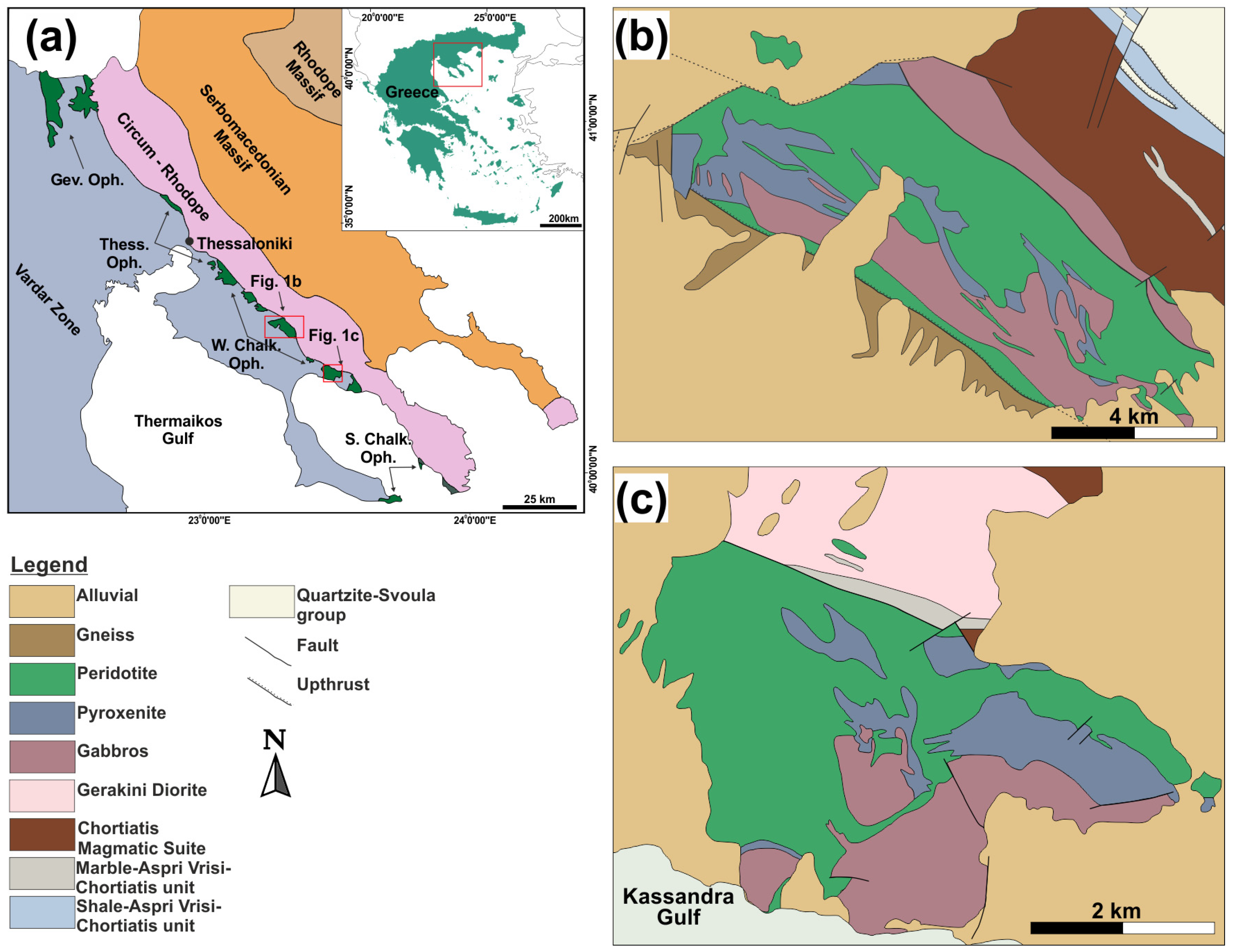

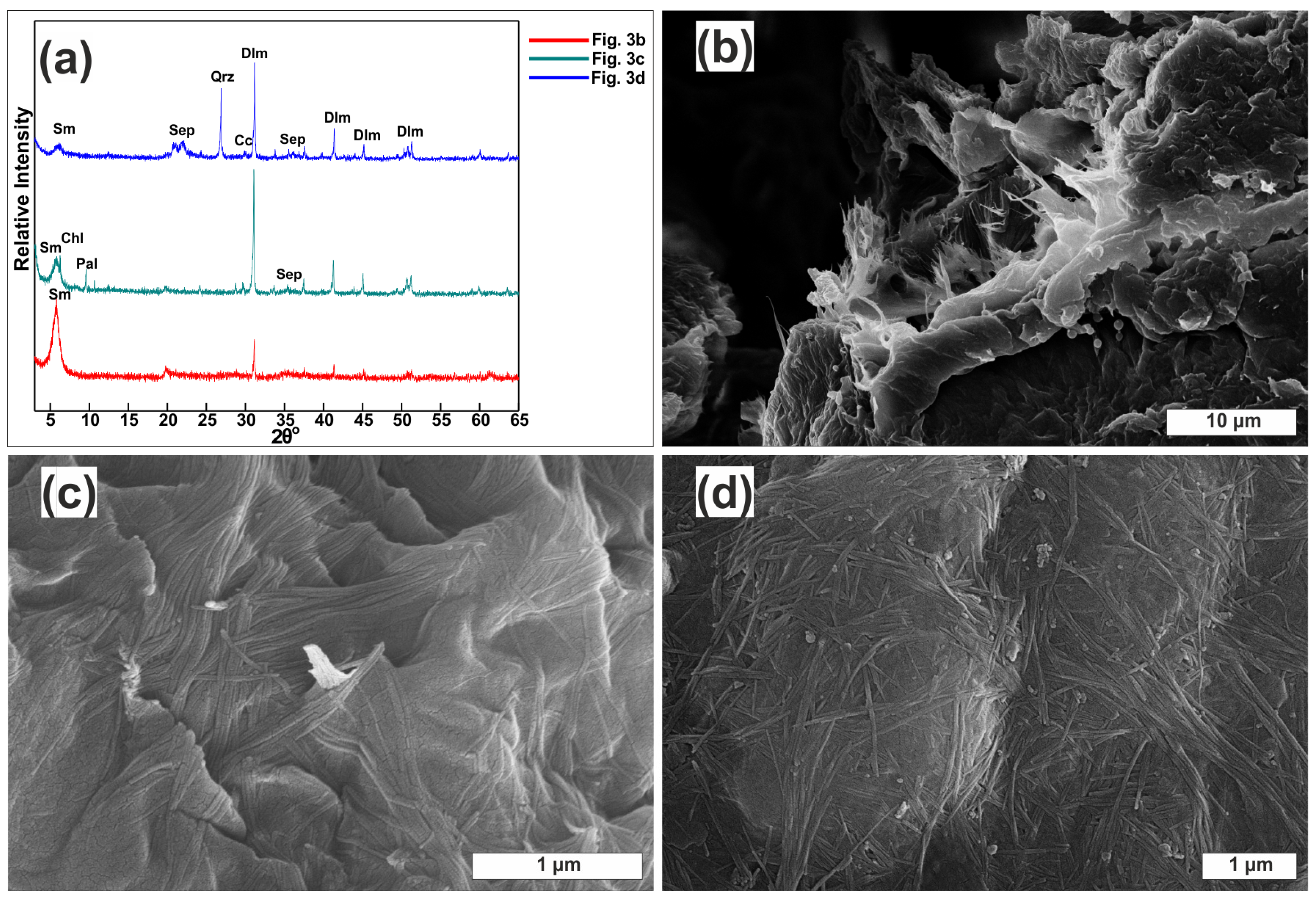
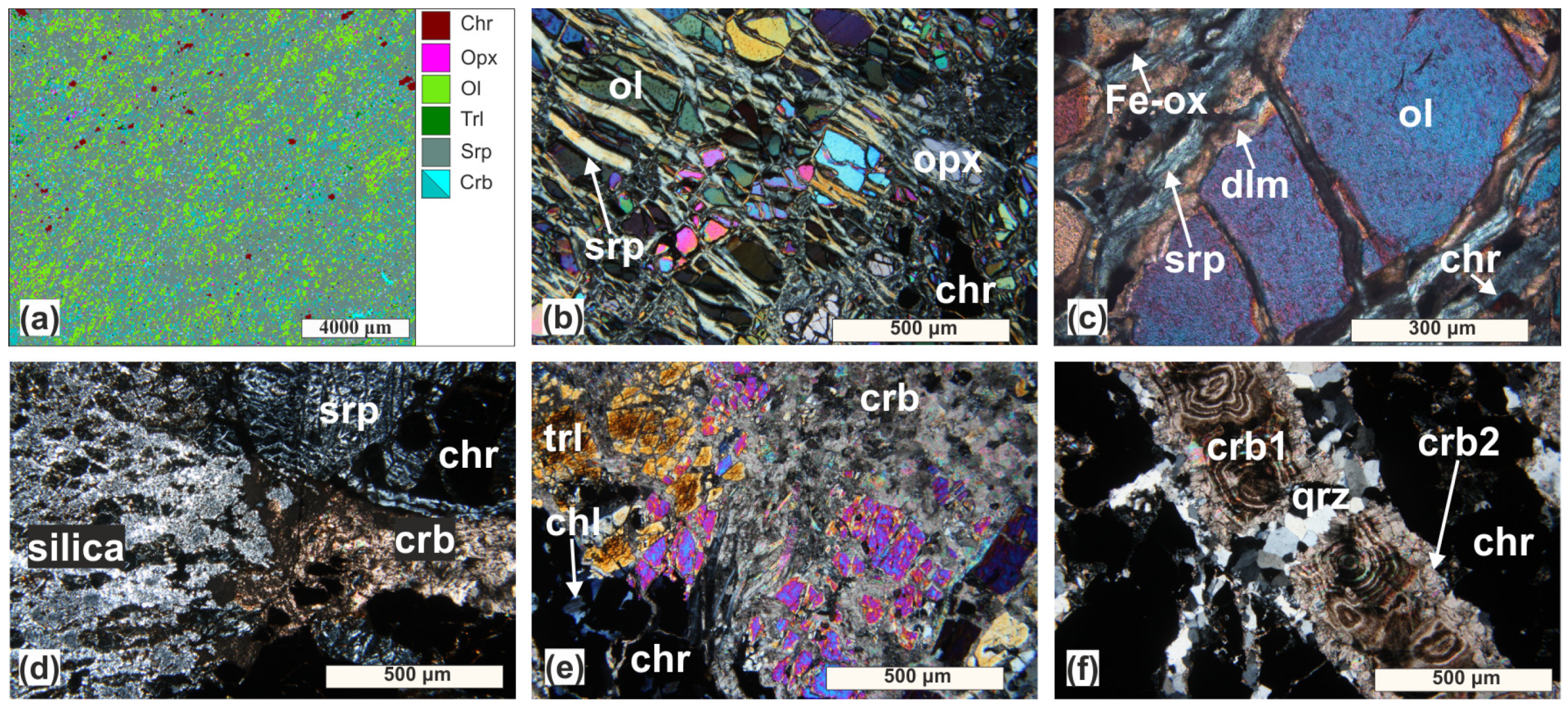


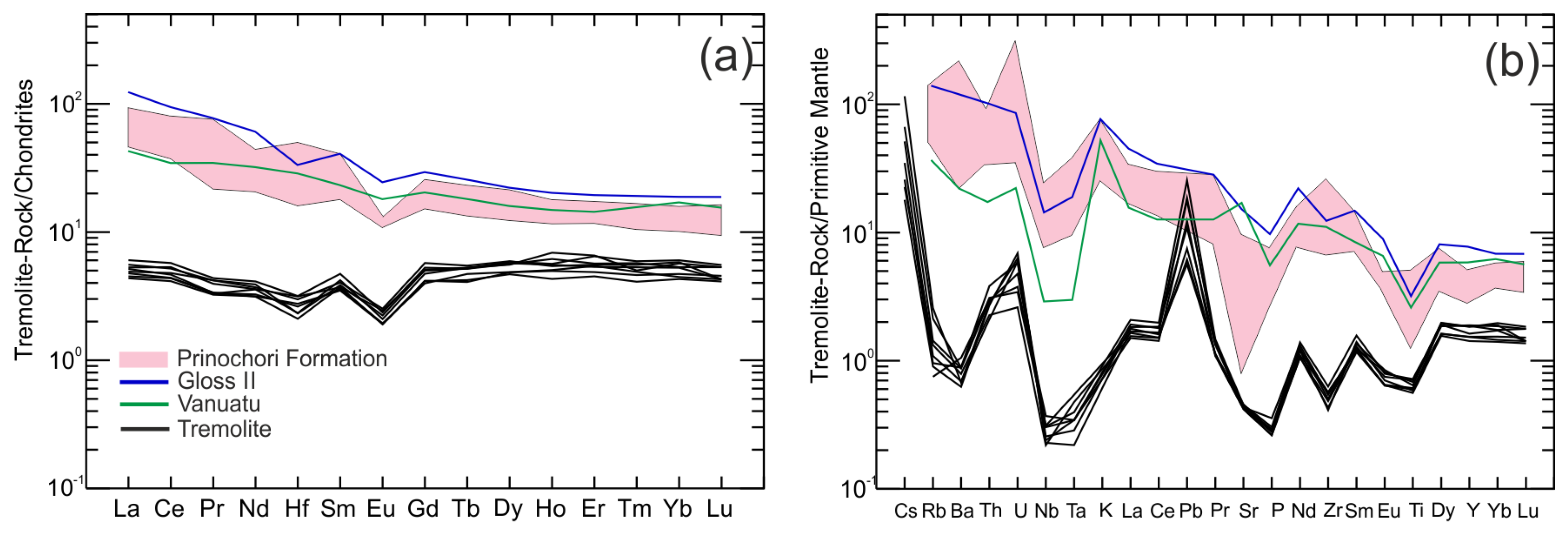
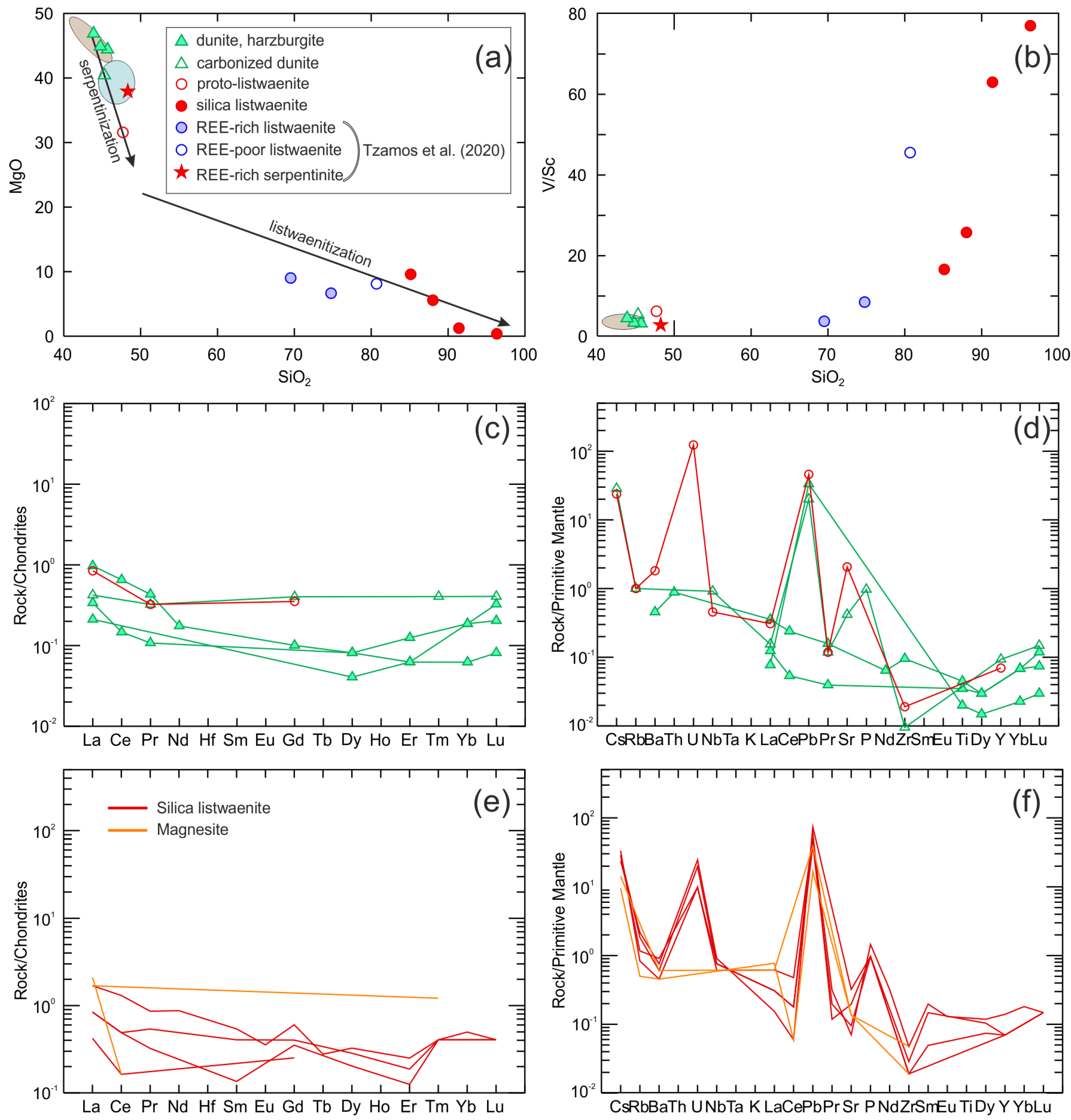

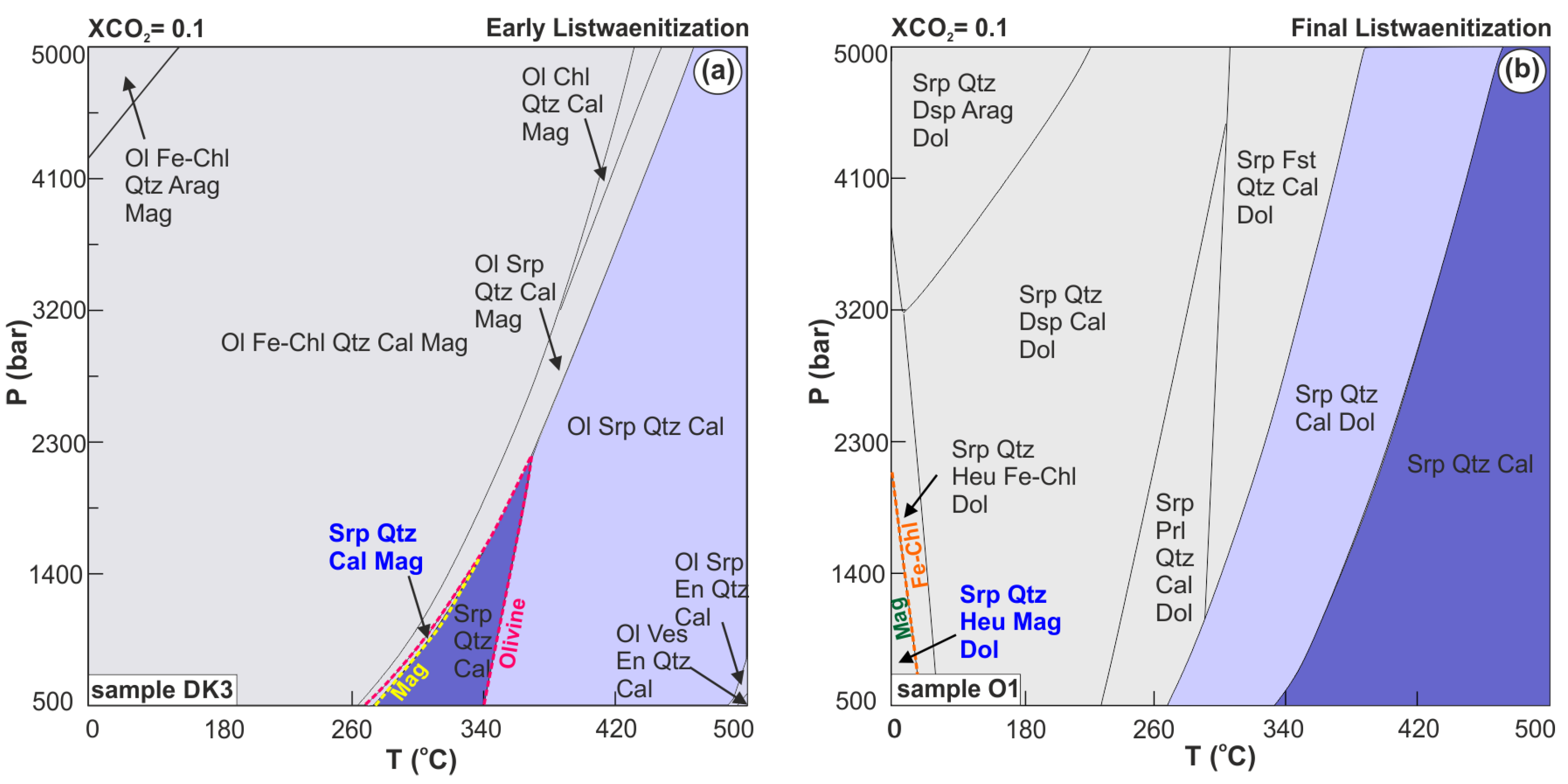
| Sample | Rock Type | SiO2 | Al2O3 | Fe2O3 | MnO | MgO | CaO | Na2O | K2O | TiO2 | P2O5 | LOI | Total |
|---|---|---|---|---|---|---|---|---|---|---|---|---|---|
| B6H | protolith_ harzburgite | 44.81 | 0.45 | 8.57 | 0.126 | 43.53 | 0.55 | - | - | 0.004 | - | 0.42 | 98.45 |
| O64 | protolith dunite | 40.61 | 0.47 | 8.36 | 0.12 | 40.71 | 0.41 | 0.02 | - | 0.007 | - | 7.88 | 98.58 |
| O62 | protolith dunite | 43.08 | 0.63 | 7.93 | 0.114 | 46.01 | 0.41 | - | - | 0.009 | - | 1.62 | 99.83 |
| O42 | protolith carbonitized dunite | 40.24 | 0.42 | 11.72 | 0.16 | 35.89 | 0.38 | - | - | - | 0.02 | 9.8 | 99.38 |
| DK3 | iddingsitized serpentinite (proto-listwaenite) | 38.03 | 0.2 | 9.57 | 0.12 | 25.17 | 6.65 | - | - | - | - | 18.9 | 99.55 |
| B94 | silica listwaenite | 94.3 | 0.21 | 2.9 | 0.03 | 0.37 | 0.04 | - | - | - | 0.03 | 1.9 | 99.98 |
| O1 | silica listwaenite | 87.7 | 0.09 | 5.21 | 0.07 | 1.19 | 1.66 | - | - | - | 0.02 | 3.6 | 99.95 |
| O1B | silica listwaenite | 84.54 | 0.17 | 4.91 | 0.065 | 5.35 | 0.99 | - | - | - | 0.02 | 3.79 | 99.84 |
| B83 | silica listwaenite | 80.95 | 0.37 | 4.31 | 0.06 | 9.11 | 0.27 | - | - | - | 0.02 | 4.4 | 99.84 |
| V2 | magnesite | 1.98 | - | 0.07 | - | 41.71 | 0.54 | - | - | - | - | 50.5 | 94.79 |
| V3 | magnesite | 0.3 | - | - | - | 47.06 | 0.42 | - | - | - | - | 51.4 | 99.22 |
| V4 | magnesite | 0.07 | - | - | - | 44.35 | 0.34 | - | - | - | - | 51.3 | 96.08 |
| G-3 | magnesite | 0.09 | - | - | - | 42.65 | 1.77 | - | - | - | - | 50.9 | 95.45 |
| G-4 | magnesite | 1.64 | - | 0.05 | - | 43.13 | 0.46 | - | - | - | - | 50.8 | 96.12 |
| Sample | Sc | V | Cr | Co | Ni | As | Rb | Sr | Pb | Au | |||
| B6H | 10 | 32 | 2580 | 111 | 2360 | - | - | - | 5 | - | |||
| O64 | 8 | 27 | 3090 | 102 | 2130 | - | - | - | - | - | |||
| O62 | 6 | 27 | 3280 | 117 | 2610 | - | - | - | - | - | |||
| O42 | 6 | 32 | 3220 | 135.2 | 2164 | - | 0.6 | 8.3 | 3 | 1.1 | |||
| DK3 | 4 | 25 | 5190 | 116.5 | 1637 | 0.9 | 0.6 | 41.2 | 6.9 | 1.4 | |||
| B94 | 1 | 77 | 930 | 27.1 | 542 | 3.2 | 0.7 | 1.4 | 7.9 | 5.1 | |||
| O1 | 2 | 126 | 2130 | 68.7 | 930 | 7.5 | 1.3 | 6.4 | 11.1 | 2.6 | |||
| O1B | 4 | 103 | 2120 | 61.8 | 989 | 5.7 | 1.1 | 3.9 | 9 | 3.4 | |||
| B83 | 5 | 83 | 1480 | 56.4 | 1260 | 4.8 | 0.5 | 1.9 | 6 | 3.1 | |||
| V2 | - | - | - | 1 | 27.8 | - | 0.3 | 2.7 | 2.5 | 3.1 | |||
| V3 | - | - | - | 0.6 | 409.8 | - | 0.3 | 5.2 | 4.2 | 0.9 | |||
| V4 | - | - | - | 0.2 | 39.3 | - | - | 2.7 | 5.8 | 1.8 | |||
| G-3 | - | - | - | - | 351.9 | - | - | 9.7 | 3.8 | - | |||
| G-4 | - | - | - | 0.5 | 12.6 | - | 0.4 | 3.1 | 1.8 | 0.5 |
Publisher’s Note: MDPI stays neutral with regard to jurisdictional claims in published maps and institutional affiliations. |
© 2022 by the authors. Licensee MDPI, Basel, Switzerland. This article is an open access article distributed under the terms and conditions of the Creative Commons Attribution (CC BY) license (https://creativecommons.org/licenses/by/4.0/).
Share and Cite
Sideridis, A.; Koutsovitis, P.; Tsikouras, B.; Karkalis, C.; Hauzenberger, C.; Zaccarini, F.; Tsitsanis, P.; Lazaratou, C.V.; Skliros, V.; Panagiotaras, D.; et al. Pervasive Listwaenitization: The Role of Subducted Sediments within Mantle Wedge, W. Chalkidiki Ophiolites, N. Greece. Minerals 2022, 12, 1000. https://doi.org/10.3390/min12081000
Sideridis A, Koutsovitis P, Tsikouras B, Karkalis C, Hauzenberger C, Zaccarini F, Tsitsanis P, Lazaratou CV, Skliros V, Panagiotaras D, et al. Pervasive Listwaenitization: The Role of Subducted Sediments within Mantle Wedge, W. Chalkidiki Ophiolites, N. Greece. Minerals. 2022; 12(8):1000. https://doi.org/10.3390/min12081000
Chicago/Turabian StyleSideridis, Alkiviadis, Petros Koutsovitis, Basilios Tsikouras, Christos Karkalis, Christoph Hauzenberger, Federica Zaccarini, Pavlos Tsitsanis, Christina Vasiliki Lazaratou, Vasilios Skliros, Dionisios Panagiotaras, and et al. 2022. "Pervasive Listwaenitization: The Role of Subducted Sediments within Mantle Wedge, W. Chalkidiki Ophiolites, N. Greece" Minerals 12, no. 8: 1000. https://doi.org/10.3390/min12081000
APA StyleSideridis, A., Koutsovitis, P., Tsikouras, B., Karkalis, C., Hauzenberger, C., Zaccarini, F., Tsitsanis, P., Lazaratou, C. V., Skliros, V., Panagiotaras, D., Papoulis, D., & Hatzipanagiotou, K. (2022). Pervasive Listwaenitization: The Role of Subducted Sediments within Mantle Wedge, W. Chalkidiki Ophiolites, N. Greece. Minerals, 12(8), 1000. https://doi.org/10.3390/min12081000











